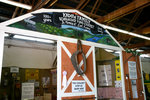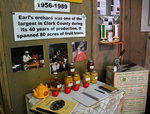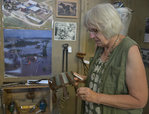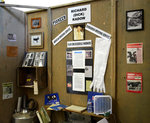



Clark County Fair’s South Barn 3 has some history in its halls, especially this year.
The Kadow family, a Clark County clan with heavy involvement with the fair in years past, with the help of local students has created the inaugural year of the Kadow Family Scholarship Fund Exhibit, showing off just a fraction of the thousands of pieces collected in the family’s name.
The exhibit is done up like a barn, bearing a facade featuring a mural that detailed the different industries of the Kadow family. Inside the wooden structure, the walls are covered in artifacts, biographies, timelines and other memorabilia.
The exhibit, new for this year, was led by Mike Kadow. He coordinated with local high school youth to design and build the structure as well as research the family and tie it to local history.
As to why there’s an exhibit for one certain Clark County farming family, it all went back to Earl, Mike’s uncle.
Former Clark County Fair Board President Earl Kadow had spent about 50 years of his life with the fair, holding different capacities over his career and eventually donating money to the fair shortly after his retirement from farming. Earl’s goal was to have an agricultural museum on the fairgrounds.
Unfortunately, upon reorganization of the fair close to Earl’s death in 2001, building and maintaining a museum for agriculture like he had hoped was deemed unfeasible.
Though Earl’s dream of a full-blown museum has been dashed, the Kadow family has come together to provide an alternative in their exhibit, featuring an amount of history within its small setup worthy of Kadow’s intentions.
Kadow family history
Five brothers came to Clark County from La Porte, Indiana at different intervals and in different trades, Mike explained. Beginning with brother Jack in the late 1800s, eventually Louis Kadow, Mike’s grandfather and Earl’s father, made the trip, spending several months setting railroad ties in the area.
Louis eventually headed back to La Porte where he married his wife, Effie Mae, before heading back to Washington to settle. When he came back, Louis went into the dairy business, which apparently drew some ribbing from his brothers as he went from a seemingly hard-working gig to something literally more pastoral.
“He would look down over his glasses and he’d hold his pipe and say ‘it was a little easier work,’” Mike recounted.
After working in the dairy business Louis was eventually able to buy his own land near Lower River Road along the Columbia River. Farmers along the river, of which Mike said there were a few at that time, would often have to deal with high water events; he mentioned specifically floods in 1948, 1962 and 1996 as being particularly bad.
Eventually two of Louis’ children, Earl and Richard, Mike’s dad, had their own farming operations in Clark County, with Richard receiving land near Vancouver Lake before moving north and Earl operating an 80-acre orchard after a career in the dairy business, running his father’s operation.
Getting the exhibit built
“Earl and my dad were very instrumental in this fair,” Mike said.
Richard was the first superintendent of the beef barn. Earl was fair president during the move from the event’s old location in Battle Ground to its current home south of Ridgefield.
While his family was working the land, Mike was out in California during and following college where he lived for several decades before retiring and moving back to Clark County. When he returned those involved with the fair contacted him to see what to do regarding Kadow’s funding and mandate.
Mike’s background was in coordinating exhibits during his career, so he fit the bill on getting something started. He said he contacted Cascadia Technical Academy to present and recruit from their design and engineering class for the build. Five CTA students took on the challenge, building the structure of the exhibit.
Mike also recruited AP History students from Fort Vancouver High School for the research portion of the exhibit. Along the walls were several biographies of Kadow history, dating back to the 19th century in Germany where the Kadow clan originated.
During the research, even those in the family were discovering about their history, including a “one-eyed, one-armed Jack,” who was Mike’s great-uncle.
Barnyard oddities
Gail Kadow Loron, whose grandfather Francis Earl “Frank” Kadow was one of the five brothers, was also minding the exhibit last week, along with Mike. She pointed out some of the more interesting objects in the exhibit, including a “calf weaner” designed to help move calves onto solid food, as well as a particularly interesting tool known as “hog tongs.”
Gail said they had no idea what the tongs were until an eagle-eyed exhibit attendee saw the obvious.
“He said, ‘oh yeah hog tongs; it says it right there,’” Gail said, pointing to some heavily weathered text on the object that at one time clearly stated what it was. The implement was used for holding a snout when the hog’s nose was pierced for a ring.
Gail’s mother, Beulah “Boots” Kadow, ran a “coffeemobile” — one of the first of its kind — for nearly two decades at the Port of Vancouver, where people on Frank’s side of the family had worked for decades. North of the port, west of Felida there’s even a marina bearing the Kadow name.
For future generations
Although the exhibit is prominent, the money that Earl sought to use for a full-blown museum will also be benefitting the community. A scholarship in Earl’s name was established this year, with the first recipients being named in 2018, just in time for the 150th anniversary of the fair.
The scholarship is designed to benefit high school students continuing their education in a variety of fields related to agriculture, which could involve anything from agriculture economics to mechanical pursuits. Mike said, for example, that someone who wanted to work on tractors would be appropriate.
Mike said the choice of funding scholarships was all about the kids — specifically getting them interested in agriculture. Although not necessarily the sole profession of the Kadow family, most members worked and learned on the farm.
“It gave us good work ethic and good discipline that we were able to carry on and use through our life,” Mike said.